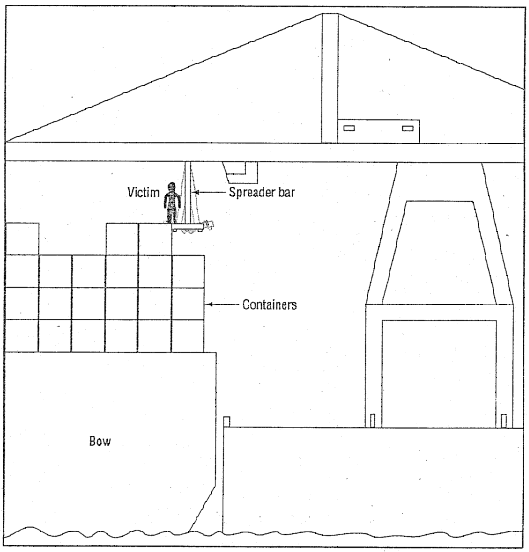Section II: Falls/Drowning Accidents
Summary No. 11 - Walking On Top Of Stacked
Containers
Hazard
Topmen removing twist locks from intermodal shipping containers were exposed to the hazard of falling from the top of the stacked containers.
Process
Longshoremen are offloading intermodal shipping containers from a vessel.
Activity at time of incident:
An employee atop a 34-foot high stack of containers was attempting to step on a crane spreader bar to reach a safety cage, when the crane operator suddenly pulled the spreader bar away from the edge of the container. NOTE: This accident predated the new standards for container top safety.
Incident Description
Setting:
Longshoremen are offloading intermodal shipping containers from a vessel moored to a pier. The containers are each 8 feet wide, 8.5 feet high, either 20 or 40 feet long, and are stacked atop one another in groups of three or four on the vessel. The topmen remove the twist locks on the containers and then it is transported to the pier by a portal crane that travels on rails along the edge of the pier. To release the containers, the topmen are carried to the top of a stack of containers via a safety cage connected to the portal crane's spreader bar, where they remove cones and twist-locks on top of the containers. The topmen are then transported via the safety cage to another location while the crane operator offloads the released containers. A gangway man on the vessel oversees the offloading operation.
Incident:
At the time of the incident, two topmen positioned atop a stack of four 40-feet-long containers were waiting to be taken via the crane safety cage to the top of another stack. As the crane operator positioned the spreader bar along the edge of the containers where the topmen were standing, one of the topmen began to step towards the spreader bar to reach the safety cage. At the same time, the crane operator received a call that another container was ready to be unloaded. When the topman was within about one foot of the container's edge, the crane operator suddenly pulled the spreader bar away. The topman was unable to stop, lost his balance, and fell over the side of the container, striking the portal crane's cross beam before landing on the pier. The topman died after falling about 60 feet. (It was 34 feet from the container top to the vessel deck and an additional 26 feet from the vessel deck to the pier.)
Relevant Factors:
The probable cause of this accident is that communication failed. The topmen did not have radios or other means to communicate with the crane operator. Topmen depend upon the crane operator for directions when accessing the cage on the spreader bar. There should have been continued communication prior to movement of the spreader bar when hoisting personnel.
Both topmen were wearing full body harnesses and were trained in the use of fall protection. However, the available fall protection system could only be used on the off shore side of the spreader bar none on the inshore side. The topmen were on the starboard side of the vessel at the time of the incident and the hookups were on the opposite side.
The crane operator, who had about 10 years of experience operating a crane, pulled the spreader bar away in order to offload another container. He saw the topman stepping about one foot from the edge of the container and assumed that the topman had time to stop. The crane operator was apparently under some time constraints, since the crane had been delayed for repairs. He decided on his own to pick up the topmen and move them to another container to remove twist-locks, in order to save time while another container was being released. The crane operator had radio communication with the gangwayman, but occasionally acted without direction from the gangwayman.
The topmen had to walk a distance of approximately 13 feet across the spreader bar to reach the safety cage. Positioning the spreader bar on the side of containers rather than on top provided easier access to the topmen, according to the crane operator.
At one point prior to the incident, the crane operator tried to signal to the topmen to get off the spreader bar and finally had to get out of the crane and yell to them to get off the bar, indicating that there was a lack of proper communication.
Applicable Standards and Control Measures
- 29 CFR 1918.85(j)(1)(I): Containerized cargo operations - Fall protection - Containers being handled by container gantry cranes. "After July 26, 1999, where a container gantry crane is being used to handle containers, the employer shall ensure that no employee is on top of a container. Exception: An employee may be on top of a container only to perform a necessary function that cannot be eliminated by the use of positive container securing devices."
- 29 CFR 1918.85(j)(1)(ii): Containerized cargo operations - Fall protection - Containers being handled by container gantry cranes. "After July 26, 1999, the employer shall ensure that positive container securing devices, such as semi-automatic twist locks and above deck cell guides, are used wherever container gantry cranes are used to hoist containers."
This hazard could have been prevented if the employer had used positive container securing devices that eliminate the need for employees to work atop the containers to release them for offloading.
Other Relevant Standards and/or Control Measures
Clearly delineate lines of authority to prohibit the crane operator from acting on his own. The crane operator should communicate with the gangwayman before performing any operations, by using, for example, a walkie-talkie or radio.

Falls/Drowning Accidents No. 11: Crane operator pulled spreader bar away as worker attempted to step on it.

